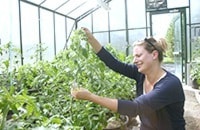Tomatoes are the premier greenhouse crop in the North Cariboo and biologist and Quesnel’s CNC greenhouse manager Jennifer Catherall was looking to investigate varieties that thrived in that environment.
After receiving funding for her tomato pilot project from Natural Sciences and Engineering Research Council of Canada, Catherall set out researching the best possible varieties from a multitude on the market, focusing on heirloom and greenhouse hybrids as her project would be carried out in the CNC unheated greenhouse which added another variable to the research.
“I am looking to see if there’s a benefit in taste, yield and potentially pest management benefits between heirloom and greenhouse hybrid tomato varieties,” she said.
Knowing she was under the gun in the North Cariboo season, Catherall was eager to get her seeds in the ground at the beginning of March.
However, she was alone in setting up her trials. Catherall has partnered with Edgewood Farm. They plant their tomatoes in the ground with hoop houses over top of the plants, simulating a greenhouse environment. Comparing plants grown directly into the ground as opposed to Catherall’s grown in pots inside an unheated greenhouse will give her that much more data.
They compared their list of potential varieties and each contributed three varieties from four categories, cherry tomatoes, paste tomatoes, greenhouse hybrids and heirloom tomatoes. In total they shared 20 varieties for comparison.
Once Catherall set to planting she devoted one half of the CNC 20X60 greenhouse to her tomato project with more than 80 plants. That half of the greenhouse has a dirt floor and all the tomato plants are in seven-gallon pots which they will remain in for the duration of the growing season.
The planting medium was standard Sunshine Mix #4, a soilless blend of peat moss and perlite. Catherall also added a slow-release tomato fertilizer to each final pot. The young plants were only given fish emulsion.
In the second half of her greenhouse, Catherall has raised beds, transplant areas, other vegetable and flower plants and the overflow of non-shared tomato varieties.
“We will still test these unshared varieties for ph and sugar content which again adds to our data base,” she said.
Catherall’s goal is to provide a preliminary guide to local growers as to their findings regarding varietal behaviour and success rates. However, each year she’d like to expand her research base and also include conversations and information gleaned from long-time local producers.
“I’d also like to try different soil combinations, there are so many variables with any growing effort,” she said.
Catherall is planning on having a comprehensive tasting sometime in August (totally dependent on her tomatoes) where she will invite local producers and others to help define the best tasting tomatoes. It will be a blind taste test and hopefully help her define what consumers consider good-tasting tomatoes.
She expects her tomato pilot project to wrap up by the end of September.
